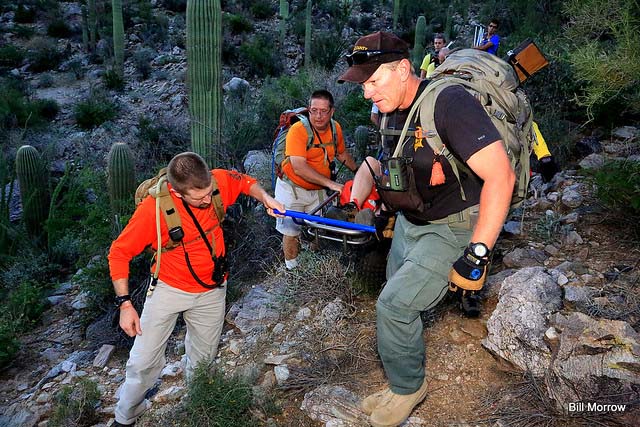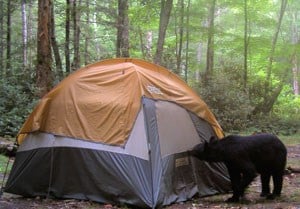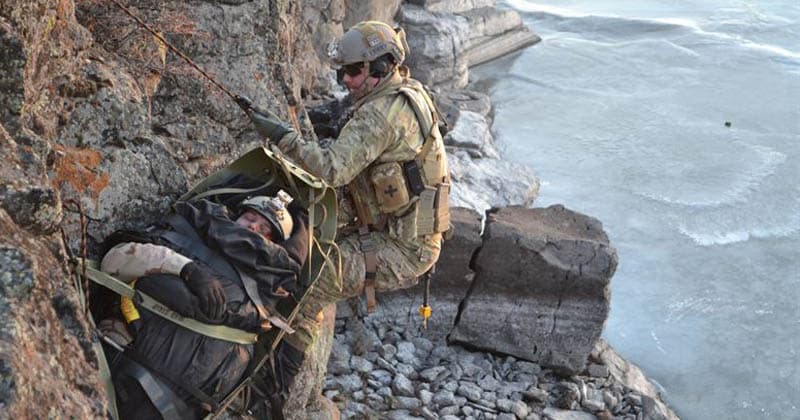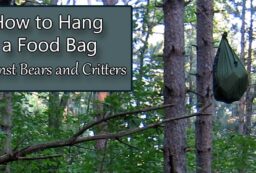I know a lot of people are afraid of nature and the idea of being in the Great Outdoors. But camping is very safe. I’m actually more afraid of getting hit by a car in the city where I live than of supposed camping dangers like getting mauled by a bear.
That said, there are some basic safety rules everyone should follow when camping, backpacking, or hiking (even on day hikes). Just Google “dies camping” in the News section and you’ll see how many people meet their death.
Virtually all of these deaths could have been avoided with just basic preparation. So, here’s the top 10 real dangers of camping – and what you can do to avoid them.
#1: Falling
When it comes to fatalities and serious injuries in National Parks, falling is one of the leading causes. I know it might seem worth it to get close to the ledge in order to get the “perfect” picture – but you really don’t want to join the ranks of the many people who die while taking a selfie (like this student or this hiker).
Then there are the falls because of risky behavior, like trying to climb a cliff without proper gear or experience. And yet others who fall on steep parts of trails because they didn’t test the sturdiness of the ground or wear proper shoes.
How to Avoid It:
- Stop taking selfies on high spots!
- Test the ground before you get close to a ledge
- Maintain a safe distance between you and other hikers on steep areas. If the person in front of you falls, you don’t want them to take you down too.
- Always wear proper footwear for hiking.
- SLOW DOWN!
- Use trekking poles (here are other reasons to use trekking poles when hiking)
#2: Widow-maker Trees
A widow-maker tree is an old, dead, or damaged tree. It makes widows when one of its branches falls off onto the tent, killing the person inside.
Yes, this happens. For example, this man died from a tree falling on his head. There are plenty of other said stories about widow-maker trees (obviously they don’t just make widows; children and women have died too).
How to Avoid It:
- Don’t camp underneath trees at all, if possible.
- Inspect trees before pitching your tent under them.
- Don’t pitch under trees which look damaged. Signs of damage can include loose bark, fungus growing, drill marks in trunk/branches from birds or insects, and branches which look different from the others.
- Avoid beech trees. These are especially dangerous.
- Avoid camping on slopes. These trees can have weak root systems and fall over.
#3: Carbon Monoxide Poisoning
How would one get carbon monoxide poisoning while camping? It happens when campers try to cook in their tents or bring heaters into their tents.
A father and his 7-year old son died this way during a Cub Scout camping trip. In another incident, a family of 5 survived, but all had to be hospitalized. Take the risk seriously. It’s better to cook in the rain or suffer through a cold night than die of CO2 poisoning!
How to avoid it:
- Never use grills, heaters, or stoves inside your tent.
- If you must, cook in your tent’s vestibule instead of inside the tent. Make sure the tent remains well ventilated the entire time.
- Know the signs of CO2 exposure.
#4: Drowning
Of all of the drownings that occur each year, nearly half of them (47.2%) are in natural water. And, as for fatalities in National Parks, over 20% of them were from swimming or boating activities.
In addition to taking caution while intentionally swimming in water, you need to be vigilant about the risk of flash flooding in canyons or ravines. Even a slight rain can cause massive flash floods in canyons, sweeping away whoever happens to be hiking there at the time. That’s what happened to four Boy Scouts on a camping trip. One of them died.
How to Avoid It:
- Wear life jackets whenever boating.
- Set clear boundaries for children in the water.
- Never swim alone in deep water.
- Don’t jump or dive into water without checking the depth first.
- Be aware of currents in rivers. Scout out potential downstream hazards (such as waterfalls or jagged rocks) before you get in.
- Never swim drunk or intoxicated.
- Don’t go hiking in a canyon when it could rain. At the first sign of rain clouds (regardless of the forecast), get the heck out of the canyon!
#5: Getting Lost

People underestimate how easy it is to get lost in the woods. If you just step off the trail for a minute, it can be hard to find your way back.
A lot of people also end up getting lost because they rely too much on their GPS, which can be inaccurate or unreliable.
According to Search and Rescue statistics, day hikers are the most at-risk. Unlike backpackers who have gear with them, day hikers often set out without much or any gear. When they get lost, this leaves them susceptible to the elements. They can quickly dehydrate or become hypothermic.
How to avoid it:
- Never stray off the trail.
- Bring a paper map and compass with you, and know how to use them.
- Be cautious at trail junctions. What seems like a trail might be a dried up stream or other natural path.
- Don’t count on your cell phone to work. Bring an emergency communication device with you.
- Always bring basic survival gear with you, even on short hikes. Here’s a list of what to bring hiking.
- Don’t let children go ahead of you, out of sight on the trail. Talk to them about what to do if lost in the woods.
#6: Wildlife Attacks

This is what most people are scared about when they go camping. But, honestly, the chances of being mauled by a bear, attacked by a cougar, bitten by a venomous snake, or any other wild animal are pretty low.
Many of the injuries or deaths that occur from wild animals were because the person didn’t follow common sense. For example, consider that bison injured more people at Yellowstone than any other animal. That’s because people approach the bison thinking they are harmless, only to get charged.
Take this video of a man who growled at a bison, provoking it to charge him. A surprising number of people are injured because of stupidity or their desire to get a wild animal selfie.
How to Avoid It:
- Research what wild animals you might encounter.
- Hang a bear bag (read how) or use a bear canister in bear country. Have bear spray with you at all times.
- Know what to do if you get bit by a snake.
- Bring tick tweezers.
- Don’t try to take selfies with wild animals.
#7: Weather Conditions
The weather on top of mountains can act much different than at low elevations. Take the Rocky Mountain National Park which is over 14,000 feet at its highest peak. The park ranks #3 for number of search and rescue missions.
Chief Ranger Mark Pita says the peaks are rife with dangers. “The temperature can drop 30-40 degrees in mere minutes, even in the summer. Lightning, sleet, hail, high winds, clouds, iced up conditions — and that can happen in August.”
Weather can lead to some freak accidents too. For example, a camper in Denmark died when high winds caused a tent stake to fly into his throat. In New Zealand, a woman died when high winds caused lifted her tent and slammed it down.
How to Avoid It:
- Be prepared for ALL weather conditions, regardless of forecasts.
- Check your gear before going camping.
- Never summit in bad weather.
- Learn about lightening safety during camping.
- Learn about avalanche safety.
- Secure your tent against wind by staking it down and pitching in the correct direction.
#8: Vehicle Accidents
Vehicle accidents are a major risk wherever you happen to be, but the risks are very different in the backcountry. People used to driving in cities might not be prepared.
For example, there are a huge number of injuries and fatalities from animal-vehicle collisions. The winding roads of some backcountry locations can result in terrible accidents. In Naatchez Trace Parkway, for example, all but two of the park’s 56 fatalities were from vehicle incidents.
Then there are freak accidents. Like this man who died when his car ran him over while he was asleep in his tent. The car was parked on a slope above the tent and apparently he’d forgotten to properly brake it.
How to Avoid It:
- Avoid driving at night.
- Drive slowly!
- Be cautious about where you park your vehicle.
- Don’t drive when you are tired.
#9: Heart Attack
Hiking is an awesome way to get some exercise, lose weight, and improve your overall health. However, it can also be very strenuous – which can trigger a coronary episode. On top of that, high altitude can increase your risk of a heart attack. For at-risk people, this can make hiking a particularly dangerous activity.
How to Avoid It:
- Know your physical limits. Don’t go on hikes that are too difficult for you.
- Go slowly and take lots of breaks. Remember to drink lots of water along the way.
- Don’t go above 8,000 feet on the first leg of a trip. Spend at least one night before going to higher elevation.
- Don’t go above 12,000 feet if you have heart disease.
- Never hike alone. Make sure your partner knows CPR.
- Bring an emergency communication device with you. Call for help at the first signs of a heart attack.
#10: Being Overly Ambitious
You spent weeks or even months planning an adventurous camping trip. Then, the day before you are set to leave, the forecast calls for terrible weather. Do you cancel your trip, or push on anyway?
In their desire to fulfill their adventurous plans, a lot of people end up taking dangerous risk. Take, for example, the many hikers who are so eager to summit that they will continue even when a lightning storm is brewing in the distance.
As a post at Section Hiker points out, saying “I don’t let the weather determine when I hike” is just plain stupid. That sort of thinking means you are letting your ego make decisions. Man is not more powerful than nature and the only thing you’ll prove by going out in bad conditions is that you are an idiot.
How to Avoid It:
- Know your physical limits and don’t push them.
- Also know the limits of your gear. Don’t take inadequate gear into situations it isn’t meant for.
- Take the weather forecast seriously.
- Be prepared to turn back.
- Don’t let your ego make bad decisions for you.
- Add a few days to your trip so you can reschedule hikes for better weather days.
- Have an exit plan.
General Camping Safety Tips
Know that Even Skilled, Fit People Can Get Hurt
The title image of this post is of an off-duty soldier being rescued. He fell from a cliff and was injured.
In another incident, an entire US Army Special Forces team needed to be rescued during a hike. Some members fell to altitude sickness and they all had to wait through the night to be rescued.
So don’t think that you are invincible. Take precautions and respect the power of the wilderness!
Always Carry Survival Gear, Even On Short Hikes
People on day hikes are the ones who need rescuing the most. The reason? They are caught unprepared when weather suddenly changes, they get lost, or are injured.
Make sure you always have survival gear with you, including:
- A change of clothing which is warm, insulating, and not made of cotton.
- Rain gear like a raincoat or poncho.
- A way of starting a fire
- Headlamp
- Map and compass
- Extra water. I also carry my Sawyer water filter.
- High-calorie snacks like granola bars
- A small first aid kit (see list here)
- Whistle
- Knife
Let Someone Know Your Plans
Even if you are hiking with a partner, still make sure someone knows your trip plans. If you don’t come back on time or check in at the designated time, they can call park rangers to start looking for you. My dad uses the SPOT finder to stay in touch while he is on his thru-hikes.
Resources:
https://www.bostonglobe.com/metro/2016/11/18/these-charts-show-most-common-reasons-people-need-rescues-national-parks/rmxtZQhUBrPDx76XIaexrI/story.html
https://www.kunc.org/post/rocky-mountain-national-park-third-most-search-and-rescues#stream/0
https://www.researchgate.net/publication/26795932_Dead_Men_Walking_Search_and_Rescue_in_US_National_Parks
https://www.nps.gov/yell/learn/news/17032.htm
https://www.outdoorlife.com/articles/survival/2015/03/danger-zone-data-ways-people-die-outdoors
https://gearjunkie.com/falling-branch-dead-tree-widowmaker-danger
https://www.naturalnavigator.com/news/2017/05/beware-the-beechs-branches/
https://www.health.harvard.edu/heart-health/ask-the-doctor-high-elevation-hiking-with-heart-attack-history
https://www.ncbi.nlm.nih.gov/pubmed/18269184
Image credits:
Title photo from a 304th Rescue Squadron exercise (U.S. Air Force photo/Staff Sgt. Daniel Delgado)
“MOUNTAIN RESCUE” (CC BY 2.0) by bill85704
https://www.nps.gov/grsm/learn/nature/dff309-focusnps1.htm













Post your comments